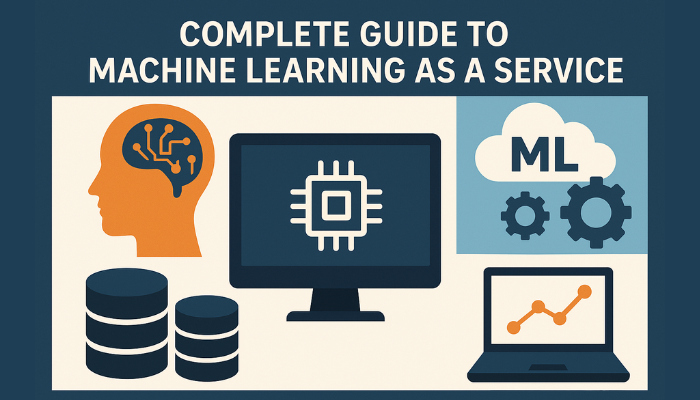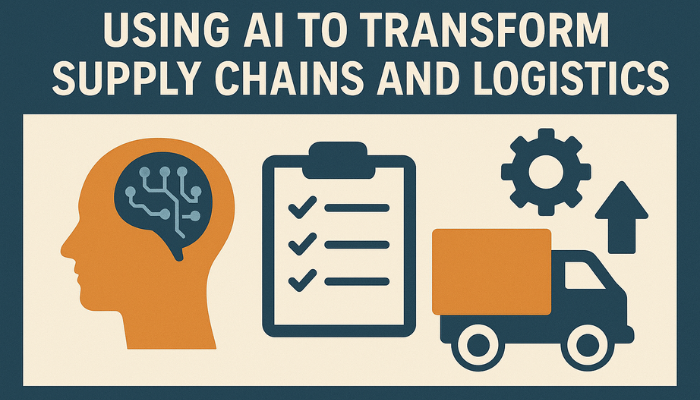If you’re exploring smarter ways to scale your data efforts without building everything from scratch, Machine Learning as a Service (MLaaS) could be exactly what your business needs.
In fact, the global MLaaS market is rapidly gaining momentum; it’s valued at around $44.2 billion in 2024 and is expected to grow to nearly $1.2 trillion by 2034, with a staggering Compound Annual Growth Rate (CAGR) of 39.3% over the next decade.
This explosive growth highlights how essential MLaaS is becoming for data-driven businesses across every industry. MLaaS helps businesses automate tasks like data analysis, predictions, image recognition, and customer insights, without needing in-house ML experts.
In this complete guide, you’ll get a clear understanding of Machine Learning as a Service, what it is and how it works. You’ll explore its core features and key benefits. The guide highlights the top MLaaS providers in 2025, covering various applications.
You’ll also examine the main challenges along with practical solutions. Learn how to choose the right provider and what to expect from the future of MLaaS.
What is Machine Learning as a Service (MLaaS)?
Machine Learning as a Service is a cloud-based solution that lets you tap into powerful machine learning tools, infrastructure, and pre-built models, without needing to build or maintain anything on your own. It’s built for businesses that want to use AI to solve real problems but don’t have the time, budget, or in-house expertise to start from scratch.
Instead of setting up servers or hiring a full data science team, you can use MLaaS platforms to train, test, and deploy models quickly, often through a simple dashboard or API. It’s a faster, more cost-effective way to bring machine learning into your workflow and start seeing results.
You know what MLaaS is, but how does it actually deliver insights and automation without requiring you to build everything from scratch? Let’s walk through how the process works step-by-step.
How Machine Learning as a Service Works
Machine Learning as a Service allows you to use machine learning without managing complex infrastructure or hiring a large data science team. Here is a clear look at how Machine Learning as a Service works in practice, so you can see exactly what steps are involved to make real-time decisions.
Step 1: Data Upload and Preparation
- You begin by uploading your business data, such as sales figures, customer records, or operational metrics, to the MLaaS platform.
- The platform provides built-in tools to clean, organize, and structure your data, ensuring it is ready for machine learning.
- Proper data preparation is essential for delivering accurate and reliable results.
Step 2: Model Selection and Training
- Next, you can choose from a range of pre-built machine learning models based on your specific business goals, such as predicting customer churn, forecasting demand, or detecting anomalies.
- Many platforms also offer automated model recommendations based on your data.
- The system handles most technical tasks, including feature selection and parameter tuning, with minimal manual effort.
Step 3: Model Evaluation and Testing
- After training, the platform evaluates the model using a portion of your data to measure its performance.
- You receive clear, easy-to-understand metrics, such as accuracy and precision, to help you decide whether the model is ready for deployment.
Step 4: Deployment and Integration
- Once you are satisfied with the model’s performance, you can deploy it directly from the MLaaS platform.
- The platform allows seamless integration with your existing systems, such as dashboards, customer apps, or Enterprise Resource Planning (ERP) tools, using Application Programming Interfaces (APIs).
- This ensures the model’s predictions are available where your team needs them most.
Step 5: Monitoring and Maintenance
- The platform continuously monitors the model’s performance in real time.
- If there is a drop in accuracy or any data drift, you receive alerts and suggestions to retrain or update the model.
- This ensures the model stays reliable as your data changes over time.
Step 6: Security and Compliance
- Leading MLaaS providers follow strict data security protocols and support key compliance standards, such as the General Data Protection Regulation (GDPR), Health Insurance Portability and Accountability Act (HIPAA), and System and Organization Controls 2 (SOC 2).
- This helps protect your sensitive data while meeting regulatory requirements, which is critical for Chief Financial Officers (CFOs), compliance officers, and decision-makers.
Struggling to make sense of raw data? Book a free consultation to turn your scattered data into clear, actionable insights.
Codewave’s AI experts help you clean, structure, and model your data for forecasting and decision-making. With tailored ML models and analytics tools, we align your data strategy with real business goals.
Knowing how MLaaS functions gives you a good foundation, but what specific tools and capabilities will you get access to? Let’s explore the core features that help you move from raw data to real results.
Core Features of Machine Learning as a Service Platforms
When you adopt MLaaS, you’re not just using a tool; you’re adding a strategic asset to your business. MLaaS platforms are built to reduce technical overhead while accelerating decision-making, helping you stay ahead in competitive markets. Below are the key features that make MLaaS a smart choice for you:
1. Complete End-to-End Machine Learning Workflow
MLaaS platforms offer complete lifecycle support for machine learning, so you can manage everything from data preparation and feature engineering to training, deployment, and performance monitoring, all in one place. This unified workflow saves time and reduces complexity, especially for teams that don’t have dedicated data scientists. Automated tools help you clean and format data, run experiments, and deploy models faster, making the entire process more efficient and less error-prone.
2. Instant and Scalable Infrastructure
You can scale resources up or down based on your current project needs without the problem of managing servers or setting up infrastructure. Whether you’re testing a small use case or rolling out an enterprise-wide AI initiative, MLaaS adjusts automatically to match your workload. This flexibility means you can respond faster to demand changes or growth opportunities without overspending on hardware.
3. Cost-Effective and Budget-Friendly
MLaaS follows a pay-as-you-go pricing model, which means you only pay for the compute power, storage, and services you actually use. There are no large upfront investments in infrastructure, which is especially useful for CFOs looking to manage risk and control IT budgets. This pricing structure also makes it easier to test new ideas without long-term financial commitments, supporting a more agile approach to innovation.
4. Strong Security and Compliance Support
Your data is protected with enterprise-grade security protocols, including encryption, identity access management, and audit logging. Leading MLaaS providers also meet major compliance standards such as GDPR, HIPAA, and SOC 2, giving you confidence that your data practices align with regulatory requirements. For organizations handling sensitive financial, healthcare, or personal data, this built-in compliance helps reduce legal risk and build stakeholder trust.
5. Automation of Time-Consuming Tasks
MLaaS automates many of the repetitive and technical tasks involved in machine learning, like data preprocessing, hyperparameter tuning, and model retraining. This allows your internal teams to focus on solving business problems instead of getting stuck in technical workflows. It also helps reduce human error and speeds up the time from concept to deployment, improving operational efficiency.
6. Predictive Analytics and Real-Time Insights
You can extract deeper value from your data by leveraging the advanced analytics tools that MLaaS platforms provide. These tools help you uncover patterns, forecast future trends, and make proactive decisions. Whether it’s predicting customer churn, optimizing inventory, or identifying fraud, MLaaS enables faster, data-driven actions with minimal setup, giving your team a clearer view of what’s ahead.
7. Smarter Personalization and Customer Experience
MLaaS allows you to build personalized experiences for your customers using data-driven insights. From dynamic pricing and product recommendations to targeted marketing campaigns, these capabilities help boost customer satisfaction and lifetime value. Personalization at scale is no longer limited to large tech companies, with MLaaS, even mid-sized businesses can deliver tailored experiences across touchpoints.
8. Seamless Integration with Business Systems
Most MLaaS platforms are built to integrate easily with your existing systems, like CRMs, ERPs, BI tools, and cloud storage, through APIs and connectors. This minimizes disruption to your current workflows and accelerates adoption across teams. Instead of rebuilding processes from scratch, you can embed machine learning insights directly into the tools your employees already use, speeding up decision-making across departments.
9. Low Maintenance and Minimal IT Overhead
The service provider takes care of software updates, infrastructure scaling, and system patches. This means your IT team won’t be bogged down by managing servers or troubleshooting model deployment pipelines. It frees up valuable internal resources to focus on high-priority initiatives rather than backend operations.
10. Competitive Edge Through Speed and Innovation
By removing the barriers to entry for machine learning, MLaaS allows you to test new ideas, launch AI-driven solutions, and bring innovations to market faster than competitors. Whether you’re looking to improve forecasting, automate manual processes, or create new revenue streams, MLaaS gives you the tools to execute quickly and efficiently. This speed of innovation can become a key differentiator in industries that demand fast adaptation.
Also Read: Machine Learning Pattern Recognition: A Beginner’s Guide
Understanding the core features helps set expectations, but where can you actually apply MLaaS? Let’s walk through some key applications where machine learning is making a direct impact on operations, revenue, and customer experience.
Applications of Machine Learning as a Service
MLaaS isn’t just a tech upgrade, it’s helping real businesses solve everyday problems faster and smarter. Below are the most practical and results-focused applications of MLaaS that can directly improve your bottom line, operational agility, and customer satisfaction.
1. Business Forecasting with Predictive Analytics
MLaaS helps you predict trends like sales performance, inventory demand, and market shifts with greater accuracy. These predictive models allow you to plan ahead, allocate resources better, and reduce financial risk. As a decision-maker, you can rely on real-time forecasts to support quarterly planning, pricing strategies, or expansion timelines, all without needing a full in-house data science team.
2. AI-Powered Customer Support and Chatbots
With MLaaS, you can easily deploy intelligent chatbots that handle routine customer queries around the clock. These bots are trained to understand intent and deliver quick, consistent responses, helping reduce call volumes and support costs. At the same time, they enhance the customer experience by minimizing wait times and maintaining brand consistency, something your customer success team will immediately benefit from.
3. Image and Video Intelligence
If your operations involve physical inspections, like in manufacturing or logistics, you can use MLaaS to automate defect detection through image recognition. In retail or security, video analytics can provide foot traffic insights or alert you to unusual activity. This real-time visibility helps you act quickly, reduce manual checks, and maintain high-quality or safety standards.
4. Natural Language Processing (NLP) for Smarter Document Handling
MLaaS enables your team to extract meaning and sentiment from emails, contracts, customer reviews, and social media posts. This helps automate document workflows, flag compliance risks, and gain insights from large volumes of text data. Whether you’re in legal, HR, or finance, NLP can reduce human error and speed up review cycles across departments.
5. Real-Time Fraud Detection and Risk Alerts
For finance, insurance, or e-commerce sectors, MLaaS can detect unusual patterns in transactions and flag potential fraud in real time. This allows you to act proactively rather than reactively, reducing exposure to loss, chargebacks, or regulatory scrutiny. It’s especially useful if your team is looking for smarter tools to support risk management and internal audit functions.
6. Personalized Customer Recommendations
MLaaS helps you serve customers with content or product suggestions based on their behavior and preferences. Whether it’s an e-commerce platform or a digital service, these personalized experiences can lift conversion rates and improve customer lifetime value. More importantly, it allows your marketing and sales teams to drive smarter cross-sell and upsell campaigns without guesswork.
7. Speech Recognition and Translation Capabilities
Convert voice to text for call summaries, customer feedback analysis, or internal meetings. MLaaS also allows for real-time language translation, making it easier to support global customers and remote teams. This is especially valuable in industries like telecom, hospitality, or B2B services where multilingual communication is part of everyday business.
8. Automated Data Protection and Compliance Monitoring
MLaaS platforms can classify sensitive data, monitor for anomalies, and enforce data handling policies. This automation reduces the burden on compliance teams and ensures you’re meeting standards like HIPAA, GDPR, or SOC 2 without extensive manual oversight. It’s an efficient way to stay audit-ready while lowering the risk of non-compliance penalties.
9. Smarter Healthcare Analytics
For healthcare providers or partners, MLaaS can analyze patient records to assist with diagnoses, suggest treatments, or predict health risks. These insights help improve clinical decisions and streamline operations across departments. Even outside traditional healthcare, companies in healthtech or insurance can use MLaaS to build better member experiences and risk models.
10. Operational Efficiency in Supply Chain and Logistics
You can use MLaaS to forecast demand, optimize delivery routes, and cut down on unnecessary operational expenses. These insights help you avoid stockouts, reduce waste, and respond quickly to supply disruptions. For businesses involved in manufacturing, distribution, or retail, this kind of predictive operations management delivers measurable cost savings and improved reliability.
MLaaS can be used for a range of applications, from predictive analytics for forecasting demand to AI-powered chatbots for customer support. But without a proper strategy, integrating MLaaS into your business can be a challenge.
At Codewave, we work closely with you to identify the best use cases, implement tailored models, and integrate MLaaS seamlessly into your workflow to drive real results.
Also Read: Understanding Machine Learning Frameworks for Model Development
So, you’ve seen where MLaaS can create real business value; the next step is choosing the right platform. Let’s explore some of the top MLaaS providers in 2025 that are helping businesses like yours turn AI into action.
Top Machine Learning as a Service Providers in 2025
If you’re trying to bring the power of AI into your business without the cost and complexity of building everything from scratch, MLaaS platforms can help you move fast, scale easily, and stay efficient. Below are six top providers in 2025 that stand out for their impact, ease of use, and value for decision-makers.
1. Microsoft Azure Machine Learning
Microsoft Azure Machine Learning is a powerful platform tailored for businesses like yours that need end-to-end machine learning capabilities. It works best if your team already uses Microsoft tools like Azure Cloud or Power BI. With automated model building, robust security, and deep MLOps integration, it supports both experimentation and enterprise-scale deployment.
Features:
- Automated ML: It helps your team build models faster by automating feature engineering, model selection, and tuning.
- Built-in MLOps: You get tools to manage the full lifecycle, development, deployment, and monitoring, all in one place.
- Easy to Scale: Whether you’re running a small pilot or a large enterprise rollout, Azure ML grows with you.
2. Google Cloud AI Platform
Google’s AI Platform is known for its flexibility and speed. Whether you need to create custom models or plug in ready-made APIs for image, text, or speech, it supports both. Integration with BigQuery also makes it a strong choice for companies already using Google’s data analytics tools.
Features:
- Pre-Built APIs: You can use AI features like image or speech recognition without building models from scratch.
- AutoML: Even non-technical teams can create custom models using drag-and-drop tools.
- BigQuery Integration: Easily connect your AI models with Google’s data analytics engine to drive real-time insights.
3. Amazon Web Services (AWS) Machine Learning
Amazon SageMaker is the centerpiece of AWS’s MLaaS offering. It provides complete control over the ML lifecycle, from data prep to model monitoring. The platform is reliable, scalable, and supports a wide variety of business use cases through its ecosystem of pre-built tools and managed services.
Features:
- Amazon SageMaker: Gives you everything to build, train, and deploy ML models, all in one managed platform.
- AutoML: Simplifies getting started by handling algorithm selection and tuning.
- AI Services: Ready-to-use features like image recognition and NLP can be added to your apps fast.
4. IBM Watson Machine Learning
IBM Watson is a strong player in industries where data privacy, compliance, and governance matter most. Its tools are built with enterprise security in mind and offer collaboration features that help large teams work efficiently. It also provides industry-specific solutions for finance, healthcare, and more.
Features:
- Full Toolset: Manage everything from data to deployment with built-in governance controls.
- Team Collaboration: Helps data teams work together more efficiently with shared environments.
- Industry-Focused: Comes with use cases and templates built for your specific industry challenges.
5. OpenAI
OpenAI leads in natural language processing and generative AI. Its models, like GPT (used in ChatGPT) and DALL·E (for image generation), enable businesses to create intelligent chatbots, summarization tools, and content generation features. You don’t need a heavy ML setup, just access the APIs and build fast.
Features:
- GPT APIs: Add intelligent conversation, summarization, or content generation into your apps with just a few lines of code.
- Image Generation: Use DALL·E to create visuals from text, great for marketing and design teams.
- Cutting-Edge Research: Stay ahead with constant updates based on the latest AI innovations.
6. Hugging Face
Hugging Face is known for its strong open-source community and large repository of pre-trained NLP models. It’s ideal for businesses that need flexible, low-code solutions for natural language processing. It also allows easy experimentation and collaboration through its tools, like Inference Spaces and AutoTrain.
Features:
- Model Hub: Thousands of pre-trained models are ready to use, so you don’t have to start from zero.
- Inference Spaces: Easily deploy and share models, speeding up collaboration and testing.
- AutoTrain: You can train and fine-tune models without writing code.
Need 24/7 customer support without overloading your team?
Schedule a call to see how Codewave’s AI chatbots and voice assistants can automate customer interactions.
We build conversational AI that understands intent, responds in real-time, and supports multiple languages. Free up your support team while improving response time and customer satisfaction.
While choosing the right provider is a big step, it’s equally important to understand the common challenges that come with MLaaS. Knowing what to expect can help you plan better and avoid costly mistakes down the road.
Challenges of Machine Learning as a Service
While MLaaS brings speed, scalability, and cost savings to your business, it also comes with its own set of challenges that can impact results if not addressed early. Knowing these hurdles and how to overcome them helps you get the most value from your investment.
1. Dealing with Poor Data Quality and Integration
If your data is scattered across outdated systems or comes in different formats, it can lead to missing or messy inputs that hurt model performance. Without clean, connected data, ML outcomes may be unreliable.
Solution:
Start by cleaning and organizing your data using proper data preparation tools. Use ETL (Extract, Transform, Load) pipelines or a central data lake to bring everything together, so your models always get consistent, usable information.
2. Complex Models
Advanced models like Large Language Models (LLMs) can be hard to manage, especially when you don’t have a big IT or data science team. Maintaining, updating, and scaling these models may stretch your resources and budget.
Solution:
Go with an MLaaS provider that supports MLOps, which automates retraining, monitoring, and model versioning. It takes the pressure off your team and helps you manage everything smoothly.
3. Lack of Model Transparency
When models act like a “black box,” it’s hard to explain or justify their decisions, especially in regulated industries where clarity matters. Without visibility, you might hesitate to rely on the results.
Solution:
Pick platforms that offer explainable AI tools like visual dashboards and traceable predictions. This helps you build trust with stakeholders and stay compliant in areas like finance or healthcare.
4. High Infrastructure and Computing Costs
Running large ML workloads requires a lot of power. If you rely only on in-house systems or pay for unused cloud capacity, costs can rise fast and slow things down.
Solution:
Move your ML jobs to scalable cloud platforms or edge computing setups. You can also use tools like Docker or Kubernetes to manage workloads more efficiently without overloading your team.
5. Misalignment Across Teams
If your business and tech teams aren’t aligned, ML projects can feel disconnected and fail to deliver real value. You need clear direction and shared goals to get results.
Solution:
Define what success looks like from the start. Make sure your IT, data, and leadership teams are in sync with regular check-ins, shared KPIs, and outcome-focused planning.
6. Feature Engineering Takes Too Long
Turning raw data into something a model can learn from, known as feature engineering, can slow things down if done manually. It also requires technical skills that may not be readily available.
Solution:
Use MLaaS platforms with automated feature engineering or built-in NLP tools. This helps you move faster without needing deep technical expertise at every step.
Each of these challenges has a solution, but only if your MLaaS provider is built to handle them. So, how do you pick the one that aligns with your goals and delivers real business value? Let’s explore.
How to Choose the Right Machine Learning as a Service Provider
Picking the right MLaaS provider directly affects your bottom line, data security, and how fast you can turn AI into real business results. Here’s how to make the best choice for your business:
1. Match ML Solutions to Your Business Goals
Before choosing a provider, get clear on what you want machine learning to do for your business.
- Are you trying to improve forecasting, reduce fraud, personalize customer experiences, or cut operational costs?
- Once your goals are defined, look for MLaaS providers who have already delivered results in your industry.
- Ask for case studies or client references to see how they’ve solved similar problems.
- A good provider won’t just offer tools, they’ll understand your challenges and have a roadmap to solve them.
2. Review the Platform’s Full Capabilities
Not all MLaaS platforms are built the same. You want one that supports every step, from collecting and preparing data, to building, training, deploying, and managing ML models.
- This reduces the need for multiple tools and streamlines your workflow.
- Features like AutoML (automated model building), pre-built templates, and MLOps (machine learning operations) can help your team save time, cut costs, and avoid manual errors.
- Also, check whether the platform handles both real-time and batch processing; some business use cases need instant results.
3. Check for Flexibility and Scalability
As your business grows, your ML needs will grow too. Make sure the platform can handle increasing data volumes and more complex models without performance issues.
- It should also adapt to your tech environment, whether you’re using AWS, Azure, Google Cloud, or a hybrid setup.
- A flexible MLaaS provider won’t lock you in and will let you scale when you’re ready, without needing a complete system overhaul.
4. Make Security and Compliance a Priority
You’re likely working with sensitive customer or business data. That means your MLaaS provider must follow strict security standards, like data encryption, role-based access, and multi-factor authentication.
- It should also comply with the regulations that apply to your industry, such as GDPR, HIPAA, or SOC 2.
- Ask your provider how they handle data privacy, where your data is stored, and who can access it. Security gaps can create costly risks, so this isn’t the place to compromise.
5. Look Into Performance and Uptime
If your ML models are supporting customer operations, logistics, or financial decisions, downtime can cost you. That’s why performance matters.
- Look for uptime guarantees, fast model response times, and the ability to handle heavy workloads.
- Read customer reviews, case studies, or third-party reports to confirm the provider consistently delivers under real business conditions.
6. Understand the Pricing and ROI
Cost structures can vary widely. Some platforms charge based on usage (pay-as-you-go), while others use subscription models.
- Don’t just compare price tags, look at what you’re getting.
- Make sure the pricing is clear and predictable, and check for any hidden fees (like costs for API calls, storage, or support).
- Then tie it back to ROI. Will the platform help you reduce operational costs, speed up decision-making, or open new revenue streams? A good MLaaS provider helps you do more with less.
7. Evaluate Support and Guidance
You’ll need more than just documentation, especially during setup and when scaling your ML projects. Look for providers that offer dedicated onboarding, live support, and access to technical experts.
- Some even provide training sessions or assign customer success managers.
- This kind of support ensures your team stays productive and avoids getting stuck during critical phases of deployment.
8. Ensure It Fits with Your Tech Ecosystem
Your machine learning tools shouldn’t sit in a silo. The platform should integrate smoothly with your existing systems—databases, cloud storage, analytics tools, ERP, and CRMs.
- Strong integration capabilities mean less manual work and better use of your existing data.
- Also, check if they offer ready-made connectors or APIs that make these integrations faster and easier to set up.
9. Look for Customization and Innovation
Every business has different needs. You may want to train your own models, use proprietary data, or tap into open-source tools.
- Make sure the provider lets you customize your ML workflow as needed.
- Also, pay attention to how often they update their platform or introduce new features.
- A provider that innovates regularly helps you stay ahead of competitors and adapt quickly to market changes.
10. Ask for Real-World Proof
Finally, don’t take marketing claims at face value. Ask for real-world examples, case studies, client names, and performance results.
- If possible, speak directly to reference clients in your industry.
- Also, check trusted third-party reviews or analyst rankings (like Gartner or Forrester).
- This helps you confirm that the provider can deliver on promises and truly understand your business needs.
Also Read: The Future of AI-Powered Learning: Machine Learning Apps in Education
Now that you know how to choose the right Machine Learning as a Service provider, let’s introduce you to a partner who checks all the boxes, Codewave.
Why Codewave Is the Right Partner for Your Machine Learning Journey
When it comes to MLaaS, the real challenge isn’t just building AI models; it’s getting them to deliver real business value without wasting time, money, or compute resources. That’s exactly where Codewave steps in.
With Codewave, you get more than just tools; you get strategic expertise, tailored solutions, and hands-on engineering support that’s focused on results.
Here is what you get with Codewave:
- Custom AI/ML Development: Build tailored machine learning models that help with forecasting, automation, customer insights, and smart decision-making.
- IoT and Embedded AI Integration: Embed AI into edge devices and enable real-time processing for smarter, faster responses in manufacturing, logistics, and beyond.
- Data Analytics & Business Insights: Turn raw, scattered data into meaningful insights that drive real actions across your business, faster and more accurately.
- MLOps Consulting: Automate your ML workflows with CI/CD pipelines, model monitoring, and lifecycle management, ensuring your models stay accurate and up-to-date.
- Generative AI Tools: Launch AI-powered solutions like content generation, smart chatbots, and automation that streamline operations and reduce manual work.
- Conversational AI & Video Chatbots: Deploy smart AI avatars and chatbots that handle customer queries in real-time, 24/7, improving service while freeing up your team.
- Voice Recognition & Intent Detection: Let users interact with systems through speech, using voice commands in their native language. Great for hands-free tasks, faster access, and better accessibility.
- Image & Video Intelligence: Extract actionable insights from photos and videos using facial recognition, object tracking, and scene analysis, ideal for retail, logistics, and security.
- Predictive Modeling: Use historical data to forecast risks, prevent failures, and make proactive business decisions that reduce cost and improve performance.
- Natural Language Processing (NLP): Analyze unstructured text, emails, reviews, and feedback to uncover hidden trends, customer sentiment, and business opportunities.
- Automated Machine Learning (AutoML): Quickly build and deploy models without deep data science knowledge. Save time, reduce complexity, and get faster results.
- AI-Driven Business Intelligence (BI): Get real-time dashboards that reveal trends and patterns across departments, helping you act on insights before opportunities pass.
- Self-Improving AI Systems: Let your models continuously learn and adapt to new data, becoming more accurate and effective as your business grows.
Facing roadblocks with machine learning deployment, scalability, or ROI?
Codewave helps you overcome the real challenges of MLaaS, whether it’s data quality, model performance, or operational complexity.
Contact us for a consultation and see how we can help you unlock the full value of MLaaS, without wasting time, money, or compute power.
Codewave is a UX first design thinking & digital transformation services company, designing & engineering innovative mobile apps, cloud, & edge solutions.







